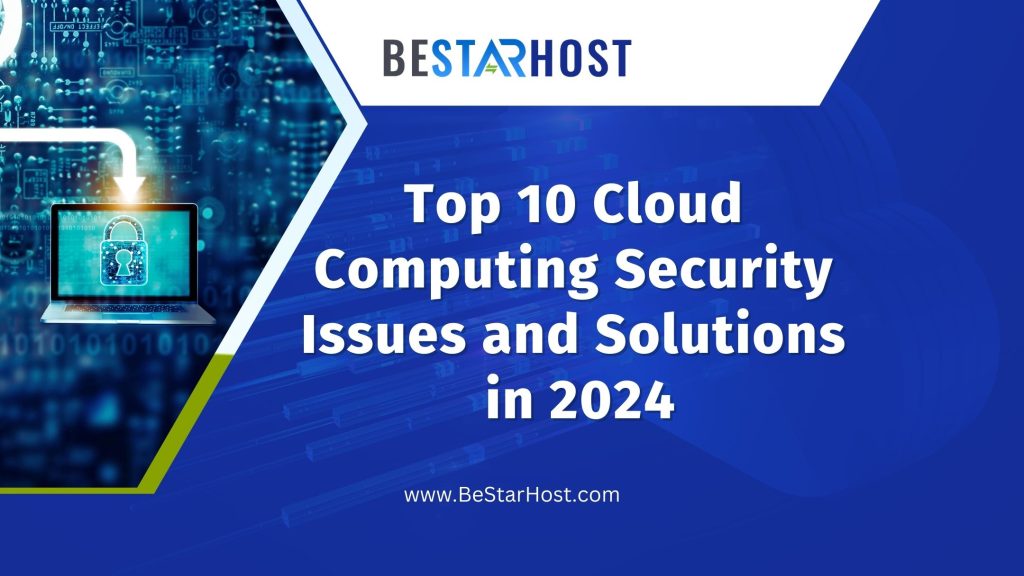
Cloud computing has become the cornerstone of modern businesses, providing unparalleled flexibility, scalability, and efficiency. However, with its myriad benefits come inherent security challenges that must be addressed to safeguard sensitive data and ensure operational integrity. In this comprehensive guide, we’ll delve into the top 10 cloud computing security issues facing businesses in 2024, along with practical solutions to mitigate these risks effectively.
-
Data Breaches and Unauthorized Access:
Data breaches remain a significant concern, with cybercriminals constantly seeking to exploit vulnerabilities in cloud environments. Solution: Implement robust encryption protocols, multi-factor authentication (MFA), and continuous monitoring to detect and mitigate unauthorized access attempts promptly.
-
Insider Threats:
Malicious insiders or negligent employees pose a significant risk to cloud security, potentially compromising sensitive data. Solution: Conduct regular security training sessions, enforce the principle of least privilege, and deploy advanced analytics tools to detect anomalous user behavior.
-
Insecure APIs:
APIs serve as the gateway between cloud services, making them a prime target for attackers aiming to exploit vulnerabilities and gain unauthorized access. Solution: Regularly audit and update API security protocols, enforce stringent access controls, and utilize API security tools to monitor and protect against potential threats.
-
Data Loss and Leakage:
The accidental or intentional exposure of sensitive data can have severe consequences for organizations, ranging from regulatory fines to reputational damage. Solution: Implement robust data loss prevention (DLP) measures, encrypt data both in transit and at rest, and leverage data classification tools to identify and protect critical information.
-
Compliance Challenges:
Meeting regulatory requirements and industry standards poses a significant challenge for businesses operating in the cloud, especially across multiple jurisdictions. Solution: Maintain thorough documentation of compliance controls, conduct regular audits, and leverage cloud compliance management tools to streamline the compliance process.
-
Cloud Misconfigurations:
Misconfigured cloud resources can inadvertently expose sensitive data or create entry points for attackers. Solution: Adopt a proactive approach to cloud configuration management, leverage automation tools for configuration enforcement, and implement robust change management processes.
-
Distributed Denial of Service (DDoS) Attacks:
DDoS attacks can disrupt cloud services, causing downtime and financial losses for organizations. Solution: Implement DDoS mitigation strategies, such as traffic filtering and rate limiting, leverage content delivery networks (CDNs) for distributed traffic management, and deploy scalable cloud architectures to absorb and mitigate attacks.
-
Inadequate Identity and Access Management (IAM):
Weak IAM practices can lead to unauthorized access, privilege escalation, and compromised accounts. Solution: Implement comprehensive IAM policies, enforce strong password policies, regularly review user access permissions, and leverage IAM solutions with advanced authentication capabilities.
-
Vendor Lock-In:
Issue: Dependence on a single cloud provider can limit flexibility and increase the risk of vendor-specific vulnerabilities. Solution: Adopt a multi-cloud or hybrid cloud strategy to diversify risk, negotiate flexible contracts with cloud providers, and implement standardized interfaces to facilitate portability between cloud environments.
-
Emerging Threats and Zero-Day Vulnerabilities:
The evolving threat landscape necessitates continuous vigilance and rapid response capabilities to mitigate emerging threats and zero-day vulnerabilities. Solution: Stay abreast of emerging security trends and vulnerabilities, implement threat intelligence feeds and security analytics platforms for early threat detection, and establish incident response protocols to mitigate the impact of security breaches promptly.
In conclusion, while cloud computing offers unparalleled opportunities for innovation and growth, it also presents complex security challenges that require diligent attention and proactive measures. By adopting a comprehensive approach to cloud security, including robust encryption, access controls, compliance management, and threat detection, organizations can effectively mitigate risks and safeguard their valuable assets in the cloud.
Remember, safeguarding your data is a continuous journey, and staying informed and proactive is key to maintaining a secure cloud environment in 2024 and beyond.
